Friday, March 5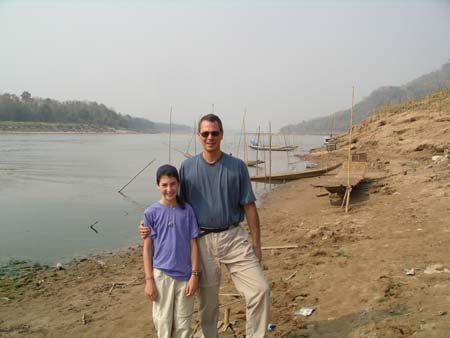
Paula: We spent today exploring life on the Mekong River. The Mekong River begins in the plateaus of Tibet and then flows over 2,600 miles until it forms a wide delta which empties into the South China Sea. Along the way, it heavily influences the economy and lives of Southern China, Myanmar (formerly Burma), Laos, Cambodia and Southern Vietnam. The Mekong River goes through the heart of Laos, which although landlocked thrives on this essential water source.
 For
our adventure today we rode on a traditional "long boat." This is
a long, narrow, flat bottomed boat that is seen up and down the Mekong River.
It has been dubbed the "slow boat" because new speed boats have
recently become more commonplace. We were quite happy on the slow boat, especially
after we saw several fast boats race
For
our adventure today we rode on a traditional "long boat." This is
a long, narrow, flat bottomed boat that is seen up and down the Mekong River.
It has been dubbed the "slow boat" because new speed boats have
recently become more commonplace. We were quite happy on the slow boat, especially
after we saw several fast boats race 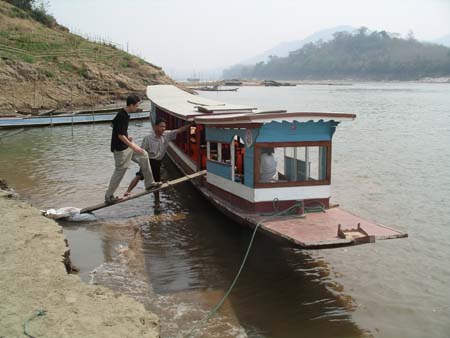 by
us. These fast boats are considered relatively dangerous and passengers must
wear helmets and rely on the skill of their captains to avoid rocks while
speeding along. The fast boat can make the trip into Thailand in six hours
while the long boat takes two days! We have read and our guide confirmed that
the noise from the engine makes it
by
us. These fast boats are considered relatively dangerous and passengers must
wear helmets and rely on the skill of their captains to avoid rocks while
speeding along. The fast boat can make the trip into Thailand in six hours
while the long boat takes two days! We have read and our guide confirmed that
the noise from the engine makes it 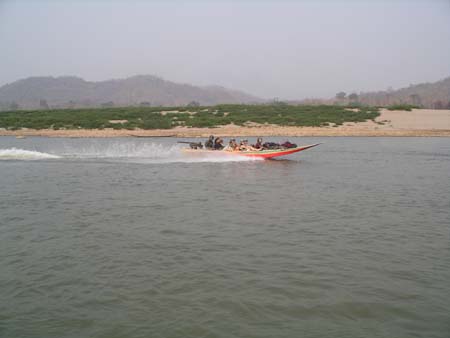 difficult
to hear for hours after your trip is completed.
difficult
to hear for hours after your trip is completed.
The occasional speed boat seemed strangely out of place as our slow boat
meandered down the peaceful Mekong. The long boat feels more like a canoe
with a roof - we had to duck our heads to get in and out. Once sitting, the
kids had fun 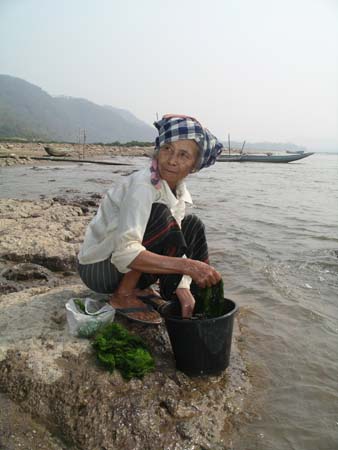 dragging
their hands in the water over the edge of the boat - that's how close we were
to being in the Mekong!
dragging
their hands in the water over the edge of the boat - that's how close we were
to being in the Mekong!
Most tourists (and there aren't too many) take boats to Tam Ting and Tam
Poum-Buddhist shrines discovered in two caves along the river's shoreline.
While we made the obligatory stop at the caves, our objective for the day
was to see how people live and use the resources of the river. As we traveled,
Nit (our guide) pointed out the variety of fishing strategies used by the
people on the river as well as the types of 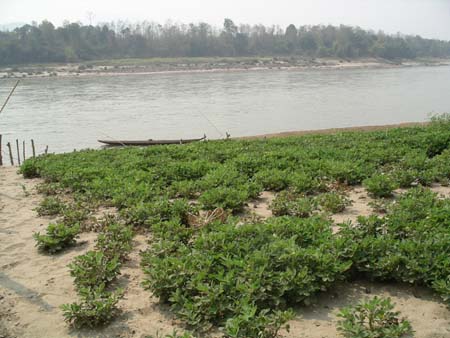 farming
and harvesting occurring along the banks. We saw people collecting Mekong
weed (a bit like seaweed) to dry and use as a food source. We saw peanuts
(pictured here) and a variety of vegetables and fruits growing in the sandy
soil at the base of the river. We also saw villagers loading boats full of
produce and timber to take to the markets in Luang Prabang.
farming
and harvesting occurring along the banks. We saw people collecting Mekong
weed (a bit like seaweed) to dry and use as a food source. We saw peanuts
(pictured here) and a variety of vegetables and fruits growing in the sandy
soil at the base of the river. We also saw villagers loading boats full of
produce and timber to take to the markets in Luang Prabang.

We first stopped at a village called Ban Mouan Kham, where the Mekong weed
is particularly important. We spoke to several older women cleaning the weeds
on the water's edge and saw younger people waist deep in water collecting
it from the rocky bottom. We then climbed up the steep shore into the village where we found many girls and women laying the weed on bamboo
flats to dry. They were also adding fish broth, garlic, sesame seeds and tomatoes
for seasoning. After a discussion with one of these women, we learned that
she makes 100 sheets of weed each day for an income of about $10/day . Unfortunately,
the weed is only able to be harvested for about three months a year but this
woman makes enough to store some to sell in the off-season. One of the women
in the village fried some of the weed for us to try. It was really quite tasty!
into the village where we found many girls and women laying the weed on bamboo
flats to dry. They were also adding fish broth, garlic, sesame seeds and tomatoes
for seasoning. After a discussion with one of these women, we learned that
she makes 100 sheets of weed each day for an income of about $10/day . Unfortunately,
the weed is only able to be harvested for about three months a year but this
woman makes enough to store some to sell in the off-season. One of the women
in the village fried some of the weed for us to try. It was really quite tasty!
This village is a typical low-lander village and is home to about 100 families.
There is a small temple and we heard the monk here bang on his drum indicating
he was ready for lunch (the villagers support the monk and temple). The village
is close enough to 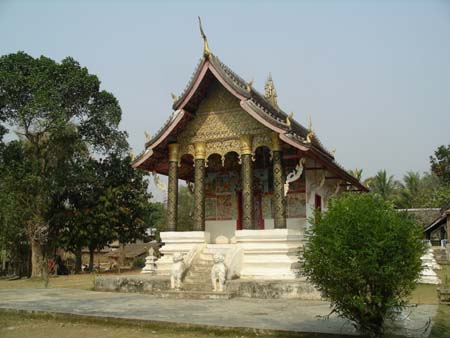 Luang
Prabang for some families to have electricity and most importantly, they are
Luang
Prabang for some families to have electricity and most importantly, they are
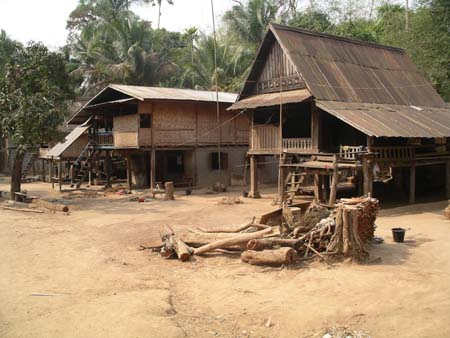 close
enough to sell their products in the markets there. Our guide Nit explained
that it costs about $100 per family to have the electricity installed and
then about one dollar a month to use it. About 70% of the families in this
village had this luxury but the only things we could see that they used it
for were TV and lighting. Cooking is done entirely over a fire and products
are all hand-made.
close
enough to sell their products in the markets there. Our guide Nit explained
that it costs about $100 per family to have the electricity installed and
then about one dollar a month to use it. About 70% of the families in this
village had this luxury but the only things we could see that they used it
for were TV and lighting. Cooking is done entirely over a fire and products
are all hand-made.

As we headed back down to our boat we noticed teak logs were being carried
down to the river so boats could make purchases 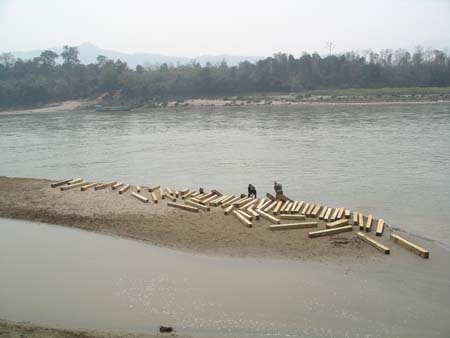 as
they made their routes up and down the river. We passed the village's garden
which included peanuts, a crop we have never seen growing before. We all enjoyed
pulling up one of the low-growing plants and examining the peanuts growing
along the roots. These fresh, salted peanuts have been our favorite snack
since arriving in Laos.
as
they made their routes up and down the river. We passed the village's garden
which included peanuts, a crop we have never seen growing before. We all enjoyed
pulling up one of the low-growing plants and examining the peanuts growing
along the roots. These fresh, salted peanuts have been our favorite snack
since arriving in Laos. 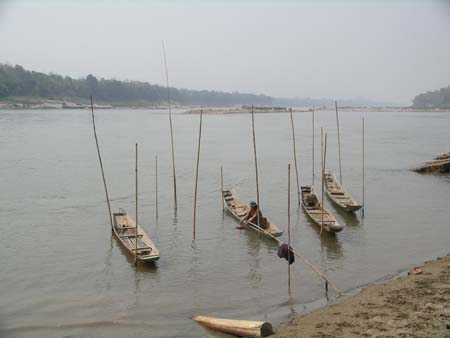
As we headed further down the river, we found it hard to believe that much
of the land being used during the current "dry season" is actually
covered over by many meters of water during the "rainy season."
The rainy season which lasts from June through August is a time of constant
heavy rain and the river level rises significantly. The people here have 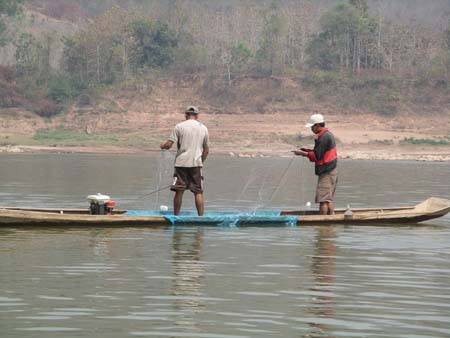 learned
to anticipate the river's changing character and know that the flooding also
brings silt and more fertile soil into the river bed which will allow them
to again grow their crops during the following dry season.
learned
to anticipate the river's changing character and know that the flooding also
brings silt and more fertile soil into the river bed which will allow them
to again grow their crops during the following dry season. 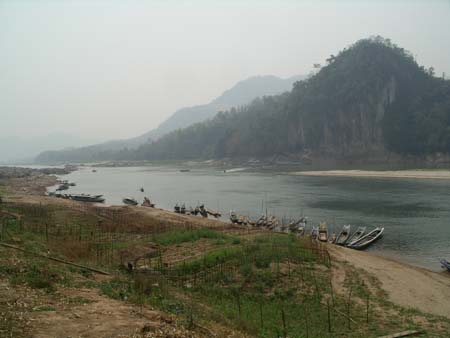
We also passed many fishermen all working in small boats setting bamboo traps
and casting lightweight nets. Although we didn't see any fish being caught
today, we have read that the fish are plentiful. We have seen many fish -
large and small being sold in the market. The area near the caves is also
good for fishing because at this point, the Ou River branches into the Mekong.
We took our boat a short ride up the Ou River which was clear and beautiful
with dramatic cliffs rising on either side. It was at this junction that we
also stopped at a small village 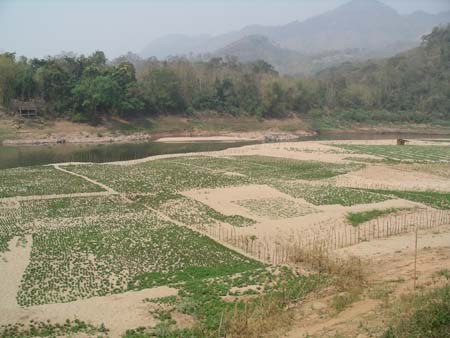 (Ban
Pak Ou) for a delicious bowl of noodle soup and sticky rice. Nit laughs at
us when we use our chop sticks to eat our rice. In Laos they only use their
chop sticks to eat noodle soup and eat their rice with their hands. From our
lunch spot, we had fun watching small boys play along the sand bars and race
across the river using bamboo poles for floatation. We also had a great view
of the largest watermelon patch we have ever seen.
(Ban
Pak Ou) for a delicious bowl of noodle soup and sticky rice. Nit laughs at
us when we use our chop sticks to eat our rice. In Laos they only use their
chop sticks to eat noodle soup and eat their rice with their hands. From our
lunch spot, we had fun watching small boys play along the sand bars and race
across the river using bamboo poles for floatation. We also had a great view
of the largest watermelon patch we have ever seen.
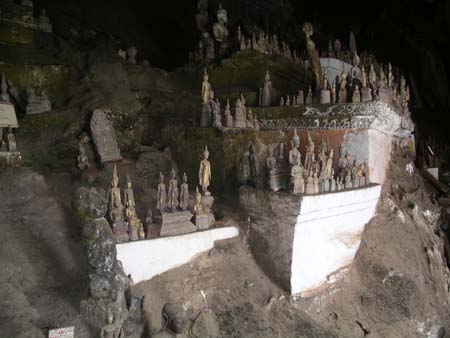 We
visited the Buddhist caves which are notable for the thousands of small Buddha
statues placed in the cave by worshippers each New Year (celebrated in April
here in Laos). From the top cave, we hiked about 40 minutes to a mid-lander
village called Ban Houey Ko. The path was covered in a bamboo and hardwoods
and the villagers were in the process of burning all the leaves that covered
the forest floor. According to Nit, this burning
We
visited the Buddhist caves which are notable for the thousands of small Buddha
statues placed in the cave by worshippers each New Year (celebrated in April
here in Laos). From the top cave, we hiked about 40 minutes to a mid-lander
village called Ban Houey Ko. The path was covered in a bamboo and hardwoods
and the villagers were in the process of burning all the leaves that covered
the forest floor. According to Nit, this burning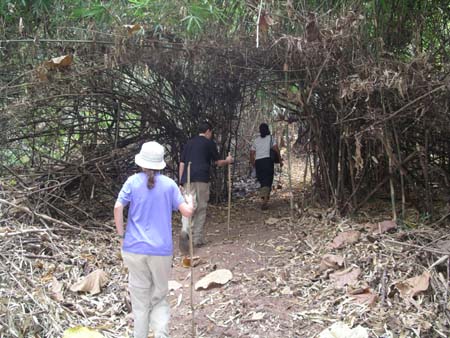 does not harm the trees and in fact is done to fertilize the soil and make
the hardwoods grow more quickly so they can be harvested for timber. There
was only a narrow path through the charcoal covered ground which was still
smoking and warm.
does not harm the trees and in fact is done to fertilize the soil and make
the hardwoods grow more quickly so they can be harvested for timber. There
was only a narrow path through the charcoal covered ground which was still
smoking and warm.
 We
had fun making walking sticks out of the bamboo poles and were reminded of
the many things we have seen made out of bamboo here. Houses, beds, cribs,
baskets, fences, cages, fish poles and rice bowls are just some of the most
obvious. Along the path we met a young boy carrying two large
We
had fun making walking sticks out of the bamboo poles and were reminded of
the many things we have seen made out of bamboo here. Houses, beds, cribs,
baskets, fences, cages, fish poles and rice bowls are just some of the most
obvious. Along the path we met a young boy carrying two large  ant nests. He told us he would eat the eggs tonight for dinner!
ant nests. He told us he would eat the eggs tonight for dinner!
Slowly the forest gave way to a field of sugar cane and we soon found ourselves
approaching a small family producing brown sugar. This family presses syrup
from the sugar cane with the assistance of an ox. The syrup is then boiled
and poured into a press where within minutes it cools into brick sized pieces
of brown sugar. This family can make about $15/day once the cane has been
harvested but it takes about nine months for the sugar cane to mature. They
sell sugar to nearby villages but are too far from Luang Prabang to sell to
this larger market. We enjoyed watching them make the 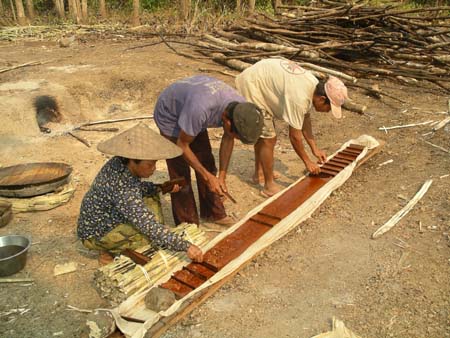 sweet
smelling sugar while also being entertained by the baby in the family. This
3 year old was using a very large knife to pare the cane!
sweet
smelling sugar while also being entertained by the baby in the family. This
3 year old was using a very large knife to pare the cane!
As we finished our walk into the village, we immediately noticed the large
number of men, women and children wandering about. Our guide discovered that
it was a Buddhist holiday so there was no school or work today. We enjoyed
talking with several families and sharing the ages of our 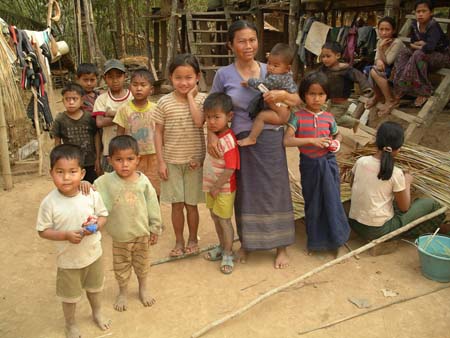 children.
The villagers were again surprised at how young David and Katie are - by Lao
standards they were tall enough to be 3-4 years older. They also commented
again on the fact that David should soon be married and even asked to be invited
to the wedding! In this village, like the others we have visited, most people
get married at age 14 or 15. The villagers wondered why Steve and I had only
two children. We again were
children.
The villagers were again surprised at how young David and Katie are - by Lao
standards they were tall enough to be 3-4 years older. They also commented
again on the fact that David should soon be married and even asked to be invited
to the wedding! In this village, like the others we have visited, most people
get married at age 14 or 15. The villagers wondered why Steve and I had only
two children. We again were 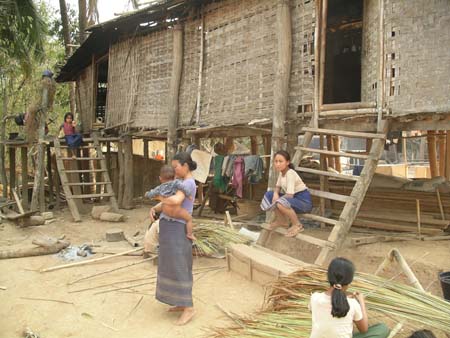 told
by each of the women how many children they had. Sadly, each answer told us
the number of children that were still living (usually 5-7) and also the total
number of children that had been born (usually 8-10). There is virtually no
medical care available for the people of these remote villages.
told
by each of the women how many children they had. Sadly, each answer told us
the number of children that were still living (usually 5-7) and also the total
number of children that had been born (usually 8-10). There is virtually no
medical care available for the people of these remote villages.
We also learned that the people in this village pan for gold. They proudly
showed us several small nuggets and we purchased one for $5 as a souvenir.
While we were in the village, we noticed several French scientists walking
around collecting soil samples and air samples. We spoke with one of them
and were interested to discover that they were conducting a study sponsored
by the United Nations. The United Nations is concerned about the effects of
mercury poisoning in 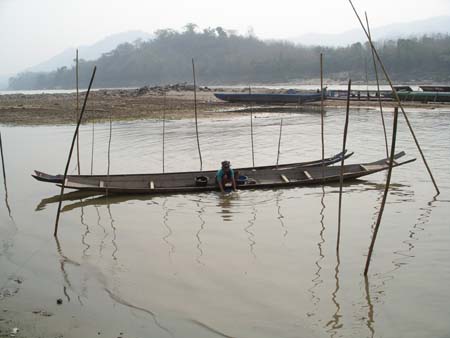 villages
where gold is panned in undeveloped areas. The mercury apparently is used
to separate the gold from other minerals. It was interesting to see the UN
in action and be in a village they were trying to help.
villages
where gold is panned in undeveloped areas. The mercury apparently is used
to separate the gold from other minerals. It was interesting to see the UN
in action and be in a village they were trying to help.
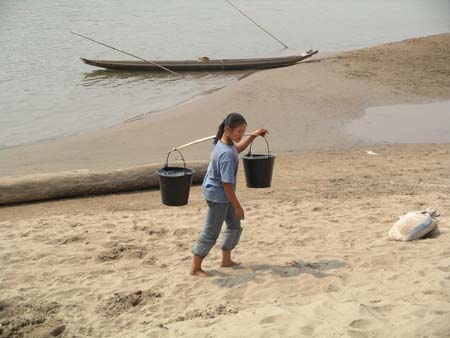 As
we headed back down the river we again took note of the ways the people along
the Mekong make use of its resources for food, water, shelter, fuel and transportation.
As the sun began to set, we noticed many people at the water's edge bathing,
washing clothing and collecting water which they carried up to the village
or to their gardens. The Mekong was more peaceful than we had imagined and
we commented on how beautiful it was with villages and mountains in the backdrop.
To the people of the Mekong though, its beauty mostly lies in its ability
to support their simple lifestyle.
As
we headed back down the river we again took note of the ways the people along
the Mekong make use of its resources for food, water, shelter, fuel and transportation.
As the sun began to set, we noticed many people at the water's edge bathing,
washing clothing and collecting water which they carried up to the village
or to their gardens. The Mekong was more peaceful than we had imagined and
we commented on how beautiful it was with villages and mountains in the backdrop.
To the people of the Mekong though, its beauty mostly lies in its ability
to support their simple lifestyle.
We also took more pictures of people in the villages that we visited today. Compared with what we found in Morocco and Russia, we've been pleasantly surprised at the willingness of people to be photographed. We always show them their pictures on our camera screen, which brings laughter and smiles. Few of these people have ever seen a digital camera. We hope to put together a collection of some of our best "people pictures" when we return.
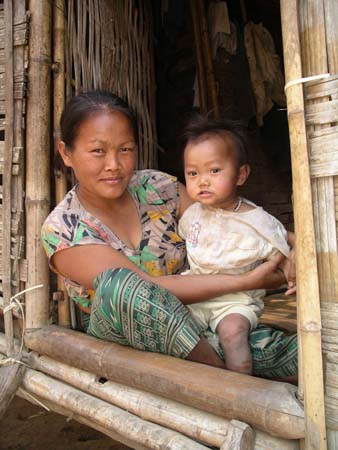
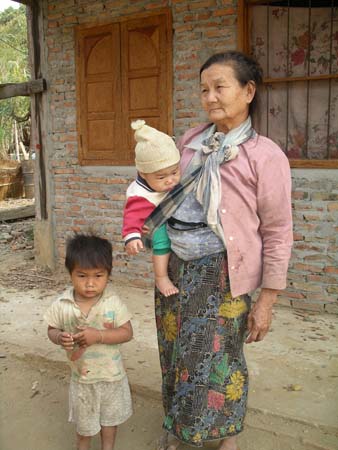
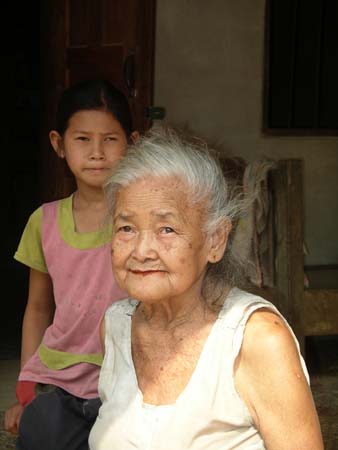

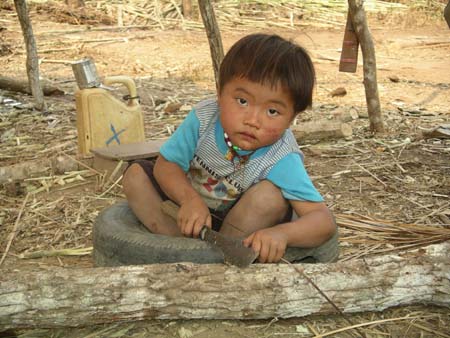
Tomorrow we have planned a relaxing day in Luang Prabang, and hope to catch up on some reading and writing.
